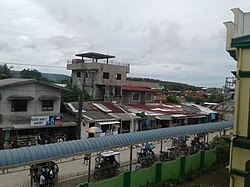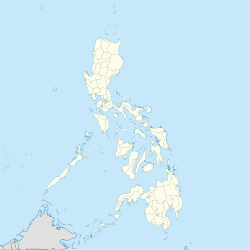San Francisco, officially the Municipality of San Francisco (Tagalog: Bayan ng San Francisco), is a 2nd class municipality in the province of Quezon, Philippines. According to the 2020 census, it has a population of 62,097 people.[3]
San Francisco
Aurora | |
|---|---|
| Municipality of San Francisco | |
 Town proper | |
 Map of Quezon with San Francisco highlighted | |
Location within the Philippines | |
| Coordinates: 13°21′N 122°31′E / 13.35°N 122.52°E | |
| Country | Philippines |
| Region | Calabarzon |
| Province | Quezon |
| District | 3rd district |
| Founded | April 27, 1938 |
| Renamed | May 11, 1940 (as Aurora) June 17, 1967 (as San Francisco) |
| Named for | St. Francis of Assisi |
| Barangays | 16 (see Barangays) |
| Government | |
| • Type | Sangguniang Bayan |
| • Mayor | Ma. Kresna E. Fernandez |
| • Vice Mayor | Rolando P. Edano |
| • Representative | Reynante U. Arrogancia |
| • Municipal Council | Members |
| • Electorate | 41,909 voters (2022) |
| Area | |
| • Total | 303.96 km2 (117.36 sq mi) |
| Elevation | 55 m (180 ft) |
| Highest elevation | 445 m (1,460 ft) |
| Lowest elevation | 0 m (0 ft) |
| Population (2020 census)[3] | |
| • Total | 62,097 |
| • Density | 200/km2 (530/sq mi) |
| • Households | 14,630 |
| Demonym(s) | Taga-San Francisco, Aurorahin |
| Economy | |
| • Income class | 2nd municipal income class |
| • Poverty incidence | 30.21 |
| • Revenue | ₱ 231.2 million (2020) |
| • Assets | ₱ 366.1 million (2020) |
| • Expenditure | ₱ 197.6 million (2020) |
| • Liabilities | ₱ 166.3 million (2020) |
| Service provider | |
| • Electricity | Quezon 1 Electric Cooperative (QUEZELCO 1) |
| Time zone | UTC+8 (PST) |
| ZIP code | 4315 |
| PSGC | |
| IDD : area code | +63 (0)42 |
| Native languages | Tagalog |
| Website | lgusanfranciscoquezon |
San Francisco is formerly called Bondo from its establishment as a town in 1938 to 1940 and Aurora from 1940 to 1967.[5][6] Located at the southernmost part of the Bondoc Peninsula and of the province, it is 185 kilometers (115 mi) from Lucena and 315 kilometers (196 mi) from Manila.
Etymology
editSan Francisco is derived from Spanish for Saint Francis of Assisi. It is formerly known as Bondo (from the Tagalog word bundok, meaning "mountain") and later Aurora (after First Lady Aurora Quezon).[7]
History
editOrigin
editThe origins of the municipality of San Francisco, formerly known as Barrio Bondo, are unclear prior to the arrival of the Spaniards in 1521. It was a forested, mountainous area with early Chinese influences, evidenced by artifacts from the Ming and Sung dynasties found along its shores. In 1784, Barrio Bondo was established under leaders Juan de Torres, Manuel Cuyo, and Gregorio Palacio. Frequent Moro pirate raids forced villagers to relocate to higher ground at Sitio Kampana for protection.
In 1898, Barrio Bondo briefly became the independent municipality of San Emilio, but financial constraints led it to revert back to being part of Mulanay by 1904.
Establishment as a municipality
editIn 1936, a group of eight men, led by Andres Castillejo, formed the Dakilang Mithi Association with the goal of separating Bondo from Mulanay to become an independent municipality. After the 1937 elections, Bondo natives gained control of the Mulanay Municipal Council and passed a resolution supporting Bondo's independence.
On April 16, 1938, Don Venancio Queblar, along with councilor Jose Allarey and Dakilang Mithi secretary Miguel Gutierez, invited President Manuel L. Quezon to visit barrio Bondo. Quezon accepted the invitation and, on April 27, 1938, declared Bondo an independent municipality on April 30, 1938, through Executive Order No. 152. The establishment took effect on July 1, 1938, with Queblar appointed as the first mayor.[8] The town originally consisted of barrios Bondo, Cawayan, Inabuan, Ilayang Tayuman, Ibabang Tayuman, Kasay, Mañongon, Pagsangahan, and Silongin, with Bondo as the seat of municipal government.[9]
Renaming
editBy virtue of the first municipal resolution, Bondo was to be renamed to Aurora, in honor of First Lady Aurora Quezon, the wife of President Quezon. On May 11, 1940, the town was renamed to Aurora by virtue of Commonwealth Act No. 527.[5]
Later, the Aurora Municipal Council sponsored Resolution No. 2, series of 1962, seeking to the change of name to San Francisco, in honor of the patron saint Francis of Assisi. The resolution was eventually sponsored by Quezon 2nd district Representative Eladio Caliwara,[7] and on June 17, 1967, Republic Act No. 4977 was enacted to finally rename Aurora to San Francisco. The renaming finally distinguished it from Maria Aurora, a municipality in Quezon established in 1949, before the creation of Aurora province, where Maria Aurora is now located.[6]
Geography
editBarangays
editSan Francisco is politically subdivided into 16 barangays. Each barangay consists of puroks and some have sitios.
- Butangiad
- Casay
- Cawayan I
- Cawayan II
- Don Juan Vercelos (Utod)
- Huyon-Uyon
- Ibabang Tayuman (Busdak)
- Ilayang Tayuman
- Inabuan
- Mabunga
- Nasalaan
- Pagsangahan
- Poblacion
- Pugon
- Santo Niño
- Silongin
Climate
edit| Climate data for San Francisco, Quezon | |||||||||||||
|---|---|---|---|---|---|---|---|---|---|---|---|---|---|
| Month | Jan | Feb | Mar | Apr | May | Jun | Jul | Aug | Sep | Oct | Nov | Dec | Year |
| Mean daily maximum °C (°F) | 27 (81) |
28 (82) |
29 (84) |
31 (88) |
31 (88) |
30 (86) |
29 (84) |
29 (84) |
29 (84) |
29 (84) |
28 (82) |
27 (81) |
29 (84) |
| Mean daily minimum °C (°F) | 21 (70) |
21 (70) |
21 (70) |
23 (73) |
24 (75) |
25 (77) |
24 (75) |
24 (75) |
24 (75) |
23 (73) |
23 (73) |
22 (72) |
23 (73) |
| Average precipitation mm (inches) | 31 (1.2) |
23 (0.9) |
25 (1.0) |
30 (1.2) |
85 (3.3) |
145 (5.7) |
182 (7.2) |
153 (6.0) |
172 (6.8) |
150 (5.9) |
113 (4.4) |
68 (2.7) |
1,177 (46.3) |
| Average rainy days | 11.3 | 8.5 | 9.7 | 11.3 | 18.3 | 23.2 | 26.6 | 25.4 | 25.9 | 24.2 | 19.7 | 15.2 | 219.3 |
| Source: Meteoblue[10] | |||||||||||||
Demographics
edit| Year | Pop. | ±% p.a. |
|---|---|---|
| 1903 | 1,330 | — |
| 1939 | 3,446 | +2.68% |
| 1948 | 4,338 | +2.59% |
| 1960 | 8,406 | +5.67% |
| 1970 | 16,954 | +7.26% |
| 1975 | 25,183 | +8.26% |
| 1980 | 33,928 | +6.14% |
| 1990 | 41,142 | +1.95% |
| 1995 | 43,457 | +1.03% |
| 2000 | 48,310 | +2.30% |
| 2007 | 53,286 | +1.36% |
| 2010 | 57,979 | +3.12% |
| 2015 | 61,473 | +1.12% |
| 2020 | 62,097 | +0.20% |
| Source: Philippine Statistics Authority[11][12][13][14] | ||
Economy
editPoverty incidence of San Francisco
10
20
30
40
50
60
70
2006
63.50 2009
41.37 2012
45.06 2015
39.26 2018
24.15 2021
30.21 Source: Philippine Statistics Authority[15][16][17][18][19][20][21][22] |
See also
editReferences
edit- ^ Municipality of San Francisco | (DILG)
- ^ "2015 Census of Population, Report No. 3 – Population, Land Area, and Population Density" (PDF). Philippine Statistics Authority. Quezon City, Philippines. August 2016. ISSN 0117-1453. Archived (PDF) from the original on May 25, 2021. Retrieved July 16, 2021.
- ^ a b Census of Population (2020). "Region IV-A (Calabarzon)". Total Population by Province, City, Municipality and Barangay. Philippine Statistics Authority. Retrieved 8 July 2021.
- ^ "PSA Releases the 2021 City and Municipal Level Poverty Estimates". Philippine Statistics Authority. 2 April 2024. Retrieved 28 April 2024.
- ^ a b Commonwealth Act No. 527 (May 11, 1940), An Act Changing the Name of the Municipality of Bondo, Province of Tayabas, to that of Aurora, The Corpus Juris, retrieved September 21, 2024
- ^ a b Republic Act No. 4977 (June 17, 1967), An Act Changing the Name of the Municipality of Aurora, Province of Quezon, to San Francisco, The Corpus Juris, retrieved January 20, 2022
- ^ a b "Origin and Political History". Municipality of San Francisco. Retrieved September 21, 2024.
- ^ "History of San Francisco". Municipality of San Francisco. Retrieved September 21, 2024.
- ^ Executive Order No. 152, s. 1938 (April 30, 1938), Organizing the Barrios of Bondo, Ilayang Tayuman, Ibabang Tayuman, Cawayan, Inabuan, Silongin, Kasay, Mañongon, and Pagsangahan, All of the Municipality of Mulanay, Tayabas, Into an Independent Municipality Under the Name of Bondo, Official Gazette, retrieved September 21, 2024
- ^ "San Francisco: Average Temperatures and Rainfall". Meteoblue. Retrieved 27 January 2020.
- ^ Census of Population (2015). "Region IV-A (Calabarzon)". Total Population by Province, City, Municipality and Barangay. Philippine Statistics Authority. Retrieved 20 June 2016.
- ^ Census of Population and Housing (2010). "Region IV-A (Calabarzon)" (PDF). Total Population by Province, City, Municipality and Barangay. National Statistics Office. Retrieved 29 June 2016.
- ^ Censuses of Population (1903–2007). "Region IV-A (Calabarzon)". Table 1. Population Enumerated in Various Censuses by Province/Highly Urbanized City: 1903 to 2007. National Statistics Office.
- ^ "Province of Quezon". Municipality Population Data. Local Water Utilities Administration Research Division. Retrieved 17 December 2016.
- ^ "Poverty incidence (PI):". Philippine Statistics Authority. Retrieved December 28, 2020.
- ^ "Estimation of Local Poverty in the Philippines" (PDF). Philippine Statistics Authority. 29 November 2005.
- ^ "2003 City and Municipal Level Poverty Estimates" (PDF). Philippine Statistics Authority. 23 March 2009.
- ^ "City and Municipal Level Poverty Estimates; 2006 and 2009" (PDF). Philippine Statistics Authority. 3 August 2012.
- ^ "2012 Municipal and City Level Poverty Estimates" (PDF). Philippine Statistics Authority. 31 May 2016.
- ^ "Municipal and City Level Small Area Poverty Estimates; 2009, 2012 and 2015". Philippine Statistics Authority. 10 July 2019.
- ^ "PSA Releases the 2018 Municipal and City Level Poverty Estimates". Philippine Statistics Authority. 15 December 2021. Retrieved 22 January 2022.
- ^ "PSA Releases the 2021 City and Municipal Level Poverty Estimates". Philippine Statistics Authority. 2 April 2024. Retrieved 28 April 2024.



